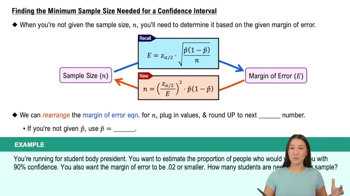In a random sample of 12 senior-level civil engineers, the mean annual earnings were \$133,326 and the standard deviation was \$36,729. Assume the annual earnings are normally distributed and construct a 95% confidence interval for the population mean annual earnings for senior-level civil engineers. Interpret the results. (Adapted from Salary.com)
Table of contents
- 1. Intro to Stats and Collecting Data1h 14m
- 2. Describing Data with Tables and Graphs1h 55m
- 3. Describing Data Numerically2h 5m
- 4. Probability2h 16m
- 5. Binomial Distribution & Discrete Random Variables3h 6m
- 6. Normal Distribution and Continuous Random Variables2h 11m
- 7. Sampling Distributions & Confidence Intervals: Mean3h 23m
- Sampling Distribution of the Sample Mean and Central Limit Theorem19m
- Distribution of Sample Mean - Excel23m
- Introduction to Confidence Intervals15m
- Confidence Intervals for Population Mean1h 18m
- Determining the Minimum Sample Size Required12m
- Finding Probabilities and T Critical Values - Excel28m
- Confidence Intervals for Population Means - Excel25m
- 8. Sampling Distributions & Confidence Intervals: Proportion1h 25m
- 9. Hypothesis Testing for One Sample3h 57m
- 10. Hypothesis Testing for Two Samples4h 50m
- Two Proportions1h 13m
- Two Proportions Hypothesis Test - Excel28m
- Two Means - Unknown, Unequal Variance1h 3m
- Two Means - Unknown Variances Hypothesis Test - Excel12m
- Two Means - Unknown, Equal Variance15m
- Two Means - Unknown, Equal Variances Hypothesis Test - Excel9m
- Two Means - Known Variance12m
- Two Means - Sigma Known Hypothesis Test - Excel21m
- Two Means - Matched Pairs (Dependent Samples)42m
- Matched Pairs Hypothesis Test - Excel12m
- 11. Correlation1h 24m
- 12. Regression1h 50m
- 13. Chi-Square Tests & Goodness of Fit2h 21m
- 14. ANOVA1h 57m
7. Sampling Distributions & Confidence Intervals: Mean
Confidence Intervals for Population Mean
Problem 6.R.8
Textbook Question
Determine the minimum sample size required to be 99% confident that the sample mean driving distance to work is within 2 miles of the population mean driving distance to work. Use the population standard deviation from Exercise 2.
 Verified step by step guidance
Verified step by step guidance1
Identify the key components of the problem: the confidence level (99%), the margin of error (2 miles), and the population standard deviation (σ), which should be provided in Exercise 2. Denote the sample size as n.
Determine the z-score corresponding to a 99% confidence level. For a 99% confidence level, the z-score is the critical value that leaves 0.5% in each tail of the standard normal distribution. Use a z-table or statistical software to find this value.
Use the formula for the margin of error in estimating a population mean: \( E = z \cdot \frac{\sigma}{\sqrt{n}} \), where E is the margin of error, z is the z-score, σ is the population standard deviation, and n is the sample size.
Rearrange the formula to solve for the sample size n: \( n = \left( \frac{z \cdot \sigma}{E} \right)^2 \). Substitute the values for z, σ, and E (2 miles) into the formula.
Perform the calculations to determine the minimum sample size n. Round up to the nearest whole number, as sample size must be an integer.
 Verified video answer for a similar problem:
Verified video answer for a similar problem:This video solution was recommended by our tutors as helpful for the problem above
Video duration:
1mPlay a video:
Was this helpful?
Key Concepts
Here are the essential concepts you must grasp in order to answer the question correctly.
Sample Size Determination
Sample size determination is the process of calculating the number of observations or replicates needed in a statistical study to ensure that the results are reliable and valid. It is influenced by the desired confidence level, the margin of error, and the population standard deviation. A larger sample size generally leads to more accurate estimates of the population parameters.
Recommended video:
Guided course

Coefficient of Determination
Confidence Level
The confidence level represents the degree of certainty that the population parameter lies within a specified range of the sample statistic. A 99% confidence level indicates that if the same sampling procedure were repeated multiple times, approximately 99% of the calculated confidence intervals would contain the true population mean. This high level of confidence typically requires a larger sample size.
Recommended video:

Introduction to Confidence Intervals
Margin of Error
The margin of error is the range within which the true population parameter is expected to lie, based on the sample statistic. In this context, a margin of error of 2 miles means that the sample mean driving distance should be within 2 miles of the actual population mean. The margin of error is influenced by the sample size and the variability of the data, with smaller margins requiring larger samples.
Recommended video:

Finding the Minimum Sample Size Needed for a Confidence Interval

 4:48m
4:48mWatch next
Master Population Standard Deviation Known with a bite sized video explanation from Patrick
Start learningRelated Videos
Related Practice
Textbook Question
35
views
